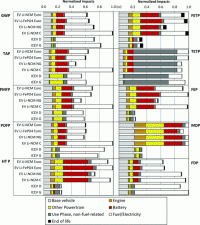October 5, 2012 report
When green turns toxic: Norwegians study Electric Vehicle life cycle

(Phys.org)—Questioning thoughts arise from a bracing study from Norway. The electric car might be a trade-in of an old set of pollution problems for a new set. Thanks but no thanks to a misguided cadre selling on the green revolution. Electric cars will eventually be one more pollutant source to campaign over. The study, "Comparative Environmental Life Cycle Assessment of Conventional and Electric Vehicles," appears in the Journal of Industrial Ecology. Researchers from the Norwegian University of Science and Technology declared in the study that "EVs exhibit the potential for significant increases in human toxicity, freshwater eco-toxicity, freshwater eutrophication, and metal depletion impacts, largely emanating from the vehicle supply chain."
The "supply chain" part of the statement is key to the focus of their research. The electric car has been promoted heavily as a car for the future but quick takes on EVs as environmental vehicles of choice should be replaced with longer and careful looks, even oversight, at what occurs during the entire cradle-to-gate life cycle of a car's production, use, and dismantling.
Light-duty vehicles account for approximately 10 percent of global energy use and greenhouse gas (GHG) emissions and policy makers have braced themselves for what that means in climate change and air quality. In the Norwegian study, the authors looked at conventional and electric vehicles to see how all phases, from production to use to dismantling, affect the environment. They concluded that, "Although EVs are an important technological breakthrough with substantial potential environmental benefits, these cannot be harnessed everywhere and in every condition. Our results clearly indicate that it is counterproductive to promote EVs in areas where electricity is primarily produced from lignite, coal, or even heavy oil combustion."
The authors warned that the "elimination of tailpipe emissions at the expense of increased emissions in the vehicle and electricity production chains" carries risks for policy makers and stakeholders. The authors support serious attention to "life cycle" thinking. Their research was partly funded by the Norwegian Research Council under the E-Car Project
Earlier this year, reports of a study of vehicle types in China concluded that electric cars have an overall impact on pollution that could be more harmful to health than conventional vehicles. The researchers in that study examined pollution in 34 Chinese cities and they found that the electricity generated by power stations to drive electric vehicles led to more fine particle emissions than petrol-powered transport. They analyzed five vehicle types—gasoline and diesel cars, diesel buses, e-bikes and e-cars.
More information: Comparative Environmental Life Cycle Assessment of Conventional and Electric Vehicles, Troy R. Hawkins, Bhawna Singh, Guillaume Majeau-Bettez, Anders Hammer Strømman, Journal of Industrial Ecology, Article first published online: 4 OCT 2012. DOI: 10.1111/j.1530-9290.2012.00532.x
Abstract
Electric vehicles (EVs) coupled with low-carbon electricity sources offer the potential for reducing greenhouse gas emissions and exposure to tailpipe emissions from personal transportation. In considering these benefits, it is important to address concerns of problem-shifting. In addition, while many studies have focused on the use phase in comparing transportation options, vehicle production is also significant when comparing conventional and EVs. We develop and provide a transparent life cycle inventory of conventional and electric vehicles and apply our inventory to assess conventional and EVs over a range of impact categories. We find that EVs powered by the present European electricity mix offer a 10% to 24% decrease in global warming potential (GWP) relative to conventional diesel or gasoline vehicles assuming lifetimes of 150,000 km. However, EVs exhibit the potential for significant increases in human toxicity, freshwater eco-toxicity, freshwater eutrophication, and metal depletion impacts, largely emanating from the vehicle supply chain. Results are sensitive to assumptions regarding electricity source, use phase energy consumption, vehicle lifetime, and battery replacement schedules. Because production impacts are more significant for EVs than conventional vehicles, assuming a vehicle lifetime of 200,000 km exaggerates the GWP benefits of EVs to 27% to 29% relative to gasoline vehicles or 17% to 20% relative to diesel. An assumption of 100,000 km decreases the benefit of EVs to 9% to 14% with respect to gasoline vehicles and results in impacts indistinguishable from those of a diesel vehicle. Improving the environmental profile of EVs requires engagement around reducing vehicle production supply chain impacts and promoting clean electricity sources in decision making regarding electricity infrastructure.
© 2012 Phys.org

















